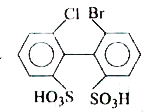Which of the following will show optical activity
_2019_CBT3_E01_025_O01.png)
_2019_CBT3_E01_025_O02.png)
_2019_CBT3_E01_025_O03.png)
_2019_CBT3_E01_025_O04.png)
The correct Answer is:A
To determine which of the given compounds shows optical activity, we need to analyze each compound for the presence of a plane of symmetry. A compound is optically active if it lacks a plane of symmetry, while the presence of a plane of symmetry indicates that the compound is optically inactive.
1. Identify the Compounds:
We have four coordination complexes to analyze for optical activity.
2. Analyze the First Compound:
- Check for a plane of symmetry.
- The first compound has no plane of symmetry.
- Conclusion: This compound is optically active.
3. Analyze the Second Compound:
- This compound is identified as a facial (FAC) isomer.
- Facial isomers typically have a plane of symmetry.
- Conclusion: This compound is optically inactive.
4. Analyze the Third Compound:
- Check for a plane of symmetry.
- The third compound has a vertical plane of symmetry that divides it into two equal halves.
- Conclusion: This compound is optically inactive.
5. Analyze the Fourth Compound:
- Check for a plane of symmetry.
- The fourth compound also has a diagonal plane of symmetry.
- Conclusion: This compound is optically inactive.
6. Final Conclusion:
- Only the first compound is optically active due to the absence of a plane of symmetry. The other three compounds are optically inactive because they have planes of symmetry.
Answer:
The first compound is the only one that shows optical activity.
---
We have four coordination complexes to analyze for optical activity.
- Check for a plane of symmetry.
- The first compound has no plane of symmetry.
- Conclusion: This compound is optically active.
- This compound is identified as a facial (FAC) isomer.
- Facial isomers typically have a plane of symmetry.
- Conclusion: This compound is optically inactive.
- Check for a plane of symmetry.
- The third compound has a vertical plane of symmetry that divides it into two equal halves.
- Conclusion: This compound is optically inactive.
- Check for a plane of symmetry.
- The fourth compound also has a diagonal plane of symmetry.
- Conclusion: This compound is optically inactive.
- Only the first compound is optically active due to the absence of a plane of symmetry. The other three compounds are optically inactive because they have planes of symmetry.
The first compound is the only one that shows optical activity.
Topper's Solved these Questions
Similar Questions
Knowledge Check
- Question 1 - Select One or More
Which of the following will show optical isomerism?
A B
B C
C D
D
- Question 2 - Select One
Which of the following will not show optical isomerism ?
ACl−CH=C=CH−ClBBr−CH=C=CH−BrC D
D
Which of the following will show optical isomerism?
View SolutionWhich of the following is not optically active?
View SolutionWhich of the following is not optically active?
View SolutionWhich of the following does not show optical activity ?
View SolutionWhich of the following is optically active?
View SolutionWhich of the following will not show optical isomerism?
View Solution

